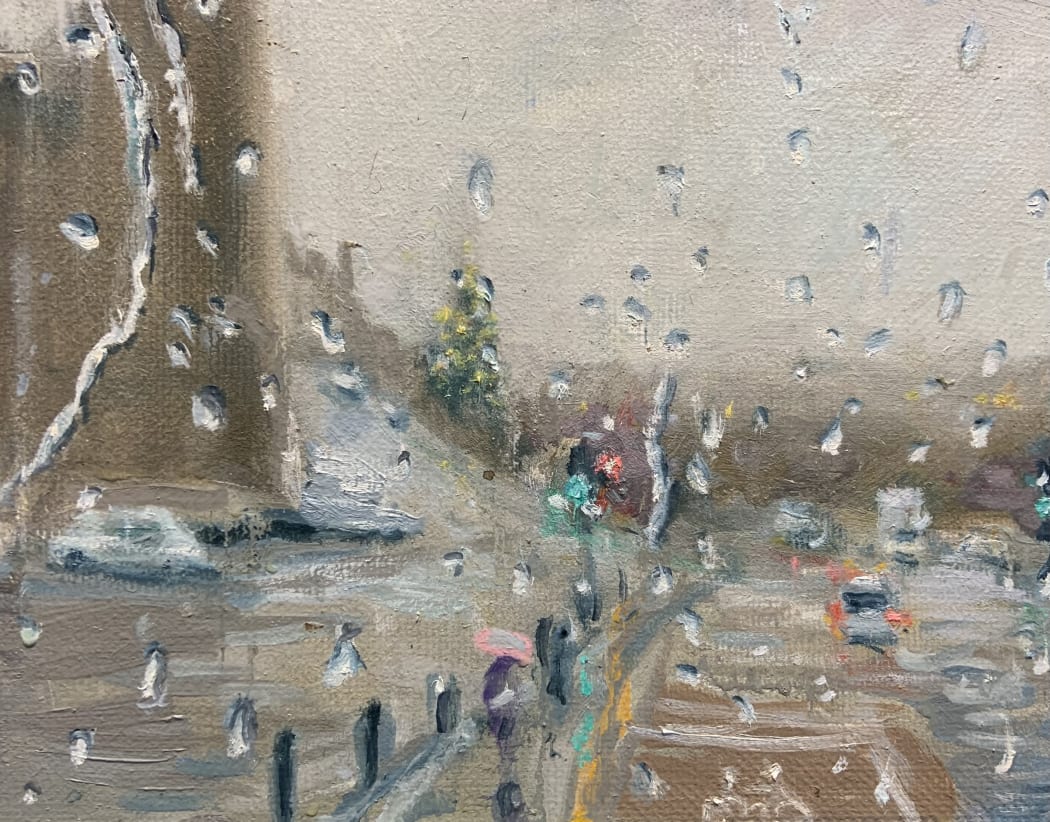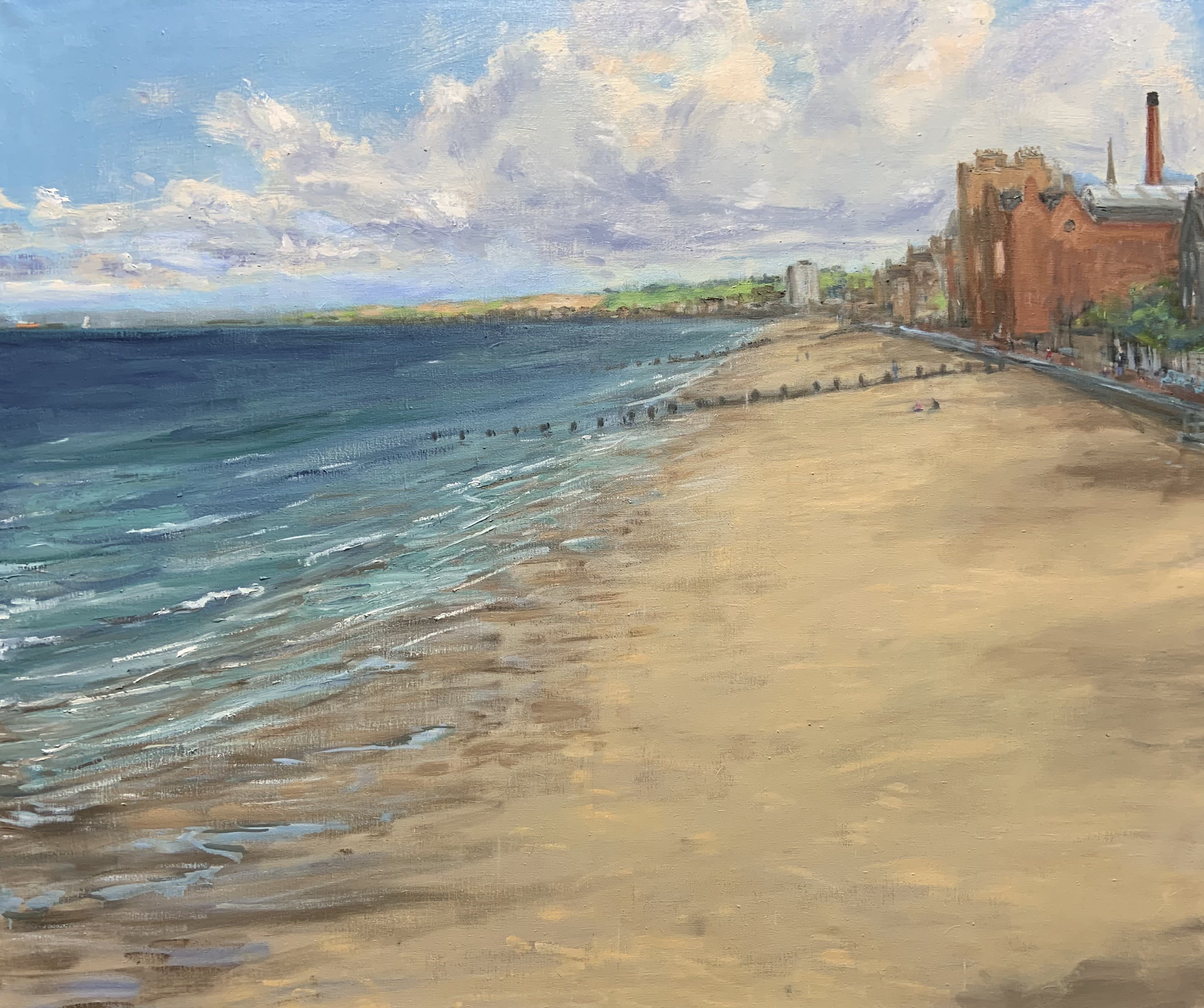
In anticipation of his exhibition Joie de vivre in the Academicians’ Gallery at the Royal Scottish Academy, Henry Kondracki RSA spoke to Gallery Manager Flora La Thangue about his practice, influences and what it means to be a painter today.
As a first generation Scot born to Polish parents, you were brought up in Edinburgh. Can you tell me about your childhood growing up in the city?
I was born at the Elsie Inglis (Maternity Hospital) in Holyrood. We lived on Royal Terrace and then moved to Union Street. My dad was the head waiter at the Beehive Inn. Once or twice a week I would go to the cinema – the Salon and the Playhouse were opposite each other, or we’d go to Rodney Street or venture out to the Regent. Within a 25-minute walk there were three big cinemas showing movies and cartoons. I’d be there all the time. I remember coming back from the cinema and saying to my mum that I wanted to paint. I was picking up images from comics and movies. I had made this picture of a cowboy with a big moustache and had pinned it up but it kept disappearing. I asked my mum where it had gone and she said that my dad thought it looked like Stalin. He had been sent to Siberia by the Russians in his youth.
When I was older I would go up to the Mound to see the exhibitions. I saw Moffat’s and Bellany’s paintings tied to the railings in front of the RSA and I remember seeing an exhibition with paintings by Paul Delvaux there. I pinched any techniques I could from older kids at school and I would copy from comics, magazines and illustrations. I remember drawing my grandfather and getting this huge buzz from capturing his likeness.
When did you first exhibit your work?
I left school at 15 and started to go round all the galleries with my portfolio. I went to see Richard Demarco and he sent me up to see Robin Philipson at Edinburgh College of Art. The first thing that Philipson said when he opened the door was ‘don’t think you’re anything special, Ricky Demarco sends people up here all the time’. Philipson told me to go and get a job and to teach myself to paint. I did go to night classes in Edinburgh; one of which was a composition class taught by David Michie.
My first show was at the Citizens Theatre in Glasgow when I was 17. I used to do voluntary work there and I had a show in the café at the theatre. My next show was at the Traverse Theatre when I was about 25. I used to paint props and scenery for them. My work from that time was all very theatrical because of working in the theatre.

Henry Kondracki RSA, Music Shop Lights. Oil on canvas.
You went to London to train at the Byam Shaw School of Art and then the Slade School of Art. How did you find being a young artist in the city?
I went to the Byam Shaw because I could apply with just my portfolio. In London I had all this access to films, theatres and galleries. I applied to the Slade School and was accepted which meant I could get a grant. I had amazing tutors at the Slade: Paula Rego, Bruce Mclean, Patrick George, Jeffery Camp, Jock McFadyen, John Hoyland and Stuart Brisley. Back then the Slade was very accommodating. Laurence Gowing was Professor of Fine Art and Coldstream was still about. It was a benign atmosphere and accepting of eccentricities. It wasn’t severe or restricting.
In the early 80s figurative painting was having a renaissance. Did you find that this influenced your work?
I was at the Slade from 1982 to 86 and everyone then was interested in Francis Bacon and figurative painting. Timothy Hyman was an important influence for me then as well. Paula Rego and I would go to the café and talk about figurative painters like John Bellany. After I left the Slade, I spent a year going round all the galleries with my portfolio and slides but Paula introduced me to the new gallerist Vanessa Devereux. Vanessa took me on and gave me a show with three weeks’ notice. I showed with Vanessa for a couple of years. Later I phoned up Mathew Flowers at Flowers Gallery and he said he’d give me a small show. I showed with Flowers for 10 years.
You returned to Edinburgh in the late 80s. Your work is very much synonymous with the city. Why did the city come back into your work?
When we moved back to Edinburgh I found myself often thinking about being more specific and looking more. I wanted the work to be less dreamy and fantasy based. Previously my work had been based on imagined scenarios and memory. I think about it like energy – when you regurgitate the same thing it loses energy. Looking, observing and drawing brings new energy. Jeffery Camp used to say that imagination comes after nature – you need the nature first. With pure imagination on its own the energy starts to run out. To renew it, the work becomes more observed, more specific.

Henry Kondracki RSA, Portobello (2023). Oil on canvas.
When I look at your work I see similarities in your use of light, mark-making and importance of the fleeting moment with the French Impressionists. Would you say that Impressionism is a major influence on your practice?
Unexpectedly, yes. When I was younger I didn’t pay any attention to it and put it in the ‘chocolate box’ category. But at the time it was completely radical, and still is if you really look at it. Sometimes Monet is more abstract than Abstract Expressionism. I think what it would be like if the Impressionists were here now. What would it be like if Bonnard came to Broughton Street? Or if Monet came to Marchmont? Sometimes I have a take on those personas. In that way fantasy is still important in my work. I think what would Degas do with this? What would Cézanne do? I love Sickert as well. His work links back to Whistler and the Impressionists.
Sometimes the Impressionists were painting en plein air but sometimes they weren’t. Bonnard was doing a little scribble and taking it back to the studio. It’s that little pulse of looking at something, and feeling, as Bonnard said, ‘weak in front of nature’. You can feel completely demolished in front of reality but then something seeps into the imagination which kicks into a memory. It might be a place or an incident. Howard Hodgkin said ‘I can make a painting from someone dropping a fork at a dinner party’. Although you’ll never see that moment in the painting you’re trying to convey that feeling. Sometimes it’s a memory from childhood or something someone said that I’m trying to get back.
Everything is moving all the time. In Edinburgh some of the city is exactly the same as it was when I was growing up. I can remember running past the Wellington Statue, being chased by a bunch of kids. Physically the thing is exactly the same but the moment has evaporated. The concrete reality is there but the lifeblood is constantly moving, constantly disappearing.
That brings us to the title of the exhibition, Joie de vivre, which implies the centrality of memory to your work. The work is full of images linked to your childhood in Edinburgh. Nostalgia is perhaps a dirty word as it speaks of a wistfulness for a past time which grates against our relentless pursuit of the new.
I don’t care if people think it’s nostalgic. I think memory is the lifeblood of creativity. Even the coldest, observational painter retains an image through their memory. The Euston Road School, with their plumb lines and measurements, were still using memory of the object retained in the mind to make a mark on the page. I extend this into the past. It has an autobiographical atmosphere. I find it exciting when I make an image and I realise why I’ve made it. Be it because of a moment or conversation. Dennis Potter said ‘I’ve scraped my very marrow to make these plays.’ It fascinates me how much I can remember – things when I was four or five years old. I can look at these places as they are now.
Today, artists can work in any medium they wish – film, photography, installation, performance. Why do you continue to paint? Why do you think painting has retained its relevance?
That’s a great question. Painting is so flexible and there’s such a huge tradition. You’re constantly thinking about that tradition and how you can make it relevant when we’re saturated with imagery. How do we make it vibrant and alive? Painting captures moving thought and freezes it. I used to stretch Jeffery Camp’s canvases and one day, whilst he was scraping paint, he remarked to me that the paint turns to rock when it dries. I remember thinking at the at the time that the paint goes onto the canvas like lava – it’s hot, alive and full of energy – and then it congeals hard, like a rock. That concreteness of your thoughts encased on the canvas makes painting as valid as making a film, writing a poem.
You look at a 400-year-old Rembrandt painting and you know what the person thinking – you can see a man just about to stand up to get a beer, or a serving girl being called away. It’s more than a photograph, it gets into your imagination and triggers a dialogue.

Henry Kondracki RSA, Casablanca at the Cameo. Oil on canvas.
You’re talking about the timelessness of painting and its transcendence of artistic movement, speaking across centuries. As a painter you can’t help but position yourself within a tradition.
You have to try to grapple with Rembrandt and all the baggage of the past. It’s a lot of pressure. But as Frank Aucherbach says, ‘diamonds are made under pressure’.
If you are a video artist or performance artist there is much less history to grapple with, much less baggage.
The baggage keeps you tough. Paula Rego used to look at my work, crunch her fists together and say: ‘Push it! Really push it!’ Every time you have to start from scratch, find some new life and excitement, whether that means going back to reality, stealing from Sickert, destroying it, whatever it takes to make it alive. As Bergman said, ‘I don’t want the films to be real, I want them to be alive.’ That’s interesting for me.
Explore Henry Kondracki RSA: Joie de vivre in the Academicians' Gallery from Saturday 21 October to Sunday 19 November.

